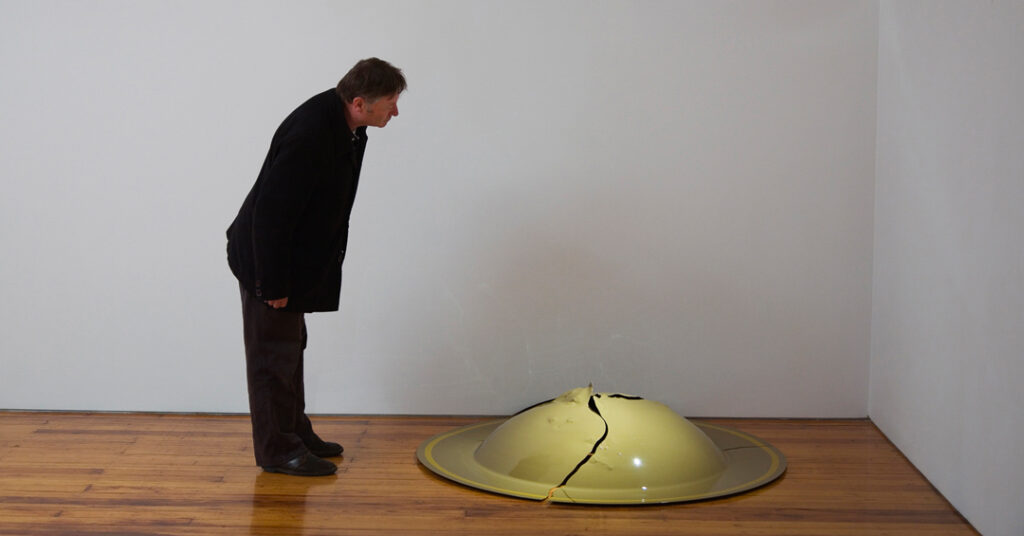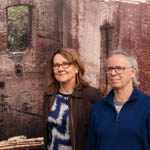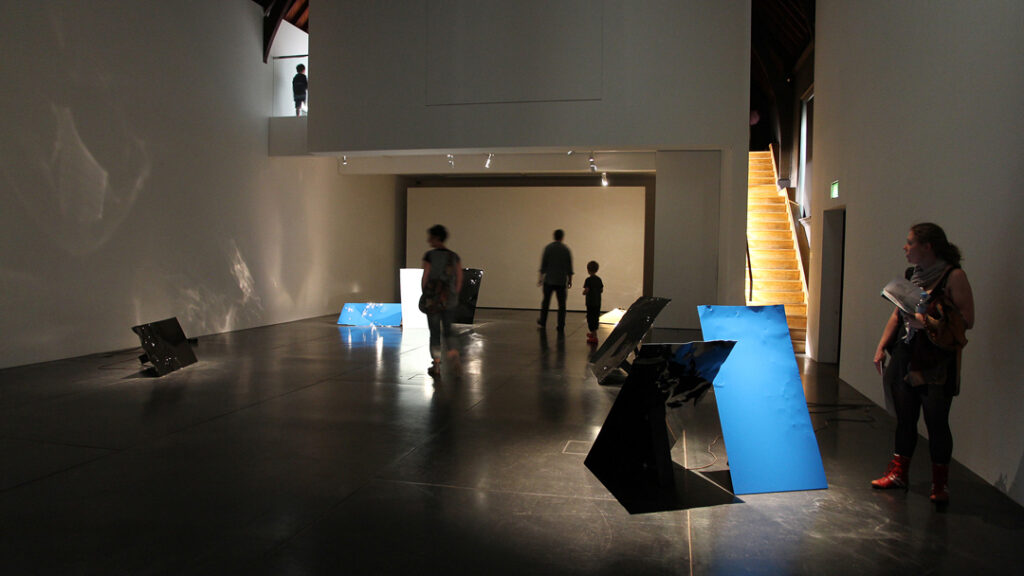
Sonia Leber and David Chesworth, Space-Shifter, 2009. Detail of installation at Conical Inc, Melbourne. Steel with 2-pack enamel paint, 14 channel audio, audio transducers, speakers. Courtesy the artists. This project has been supported by the Australia Council.
Sonia Leber writes about an exhibition that allows visitors to experience the uncanniness of the human voice, as in a cave.
(A message to the reader.)
Who can resist calling out into the reverberant void of an empty tunnel or cave? To hear your thin lone voice amplified and enlarged with more-than-human effects. Once the voice leaves the mouth, it breaks loose of its corporeal origins. It becomes untethered, unseen, at times, undisciplined. Not quite an echo but an expansion of the original voice: more impressive and portentous, an unlocatable force.
Our installation Space-Shifter summons these effects. The work was developed for Conical, an art space that operated in Melbourne from 2001-2012, a gallery uniquely available as a material space that artists could comprehensively manipulate, upturn and gouge out. The gallery’s name referenced Conical Intersect, a key work by the American artist Gordon Matta-Clark. For the Paris Biennale of 1975, he punctured large portions of two seventeenth-century residential buildings slated for demolition, in an early expression of situated spatial practice.
David Chesworth and I arrived at Conical in 2009 to bring a sonic practice to follow a long series of prior spatial interventions there. At the time, our projects were exploring a metaphysics of the human voice, and we aimed to find a way to use voices to disrupt and physically transform the space.
David and I were thinking of caves. Historically, monks and hermits favoured caves for retreat and solitude, but equally, they were sites for revelations. Visiting seekers would listen to prophesies dispensed by a remote shadowy figure whose uncanny voice would rebound around the natural void of the cave. Before electricity, before microphones and amplifiers, such natural voids—the darker, the better—were utilised to produce all kinds of sonic enhancements to the human voice.
Early religious leaders must have felt the resonant chambers of their churches and temples acting on their voices, bestowing gravitas and enhancing liturgical powers. Amplified and thickened, their solo voices would take on the characteristics of a limitless universe, perhaps elevated to the divine. Equally, the voices of a small congregation could be heard as a throng.
- Sonia Leber and David Chesworth, Space-Shifter, 2009. Detail of installation at Detached, Hobart, in association with MONA FOMA, 2012. Steel with 2-pack enamel paint, 14 channel audio, audio transducers, speakers. Courtesy the artists. This project has been supported by the Australia Council.
- Sonia Leber and David Chesworth, Space-Shifter, 2009. Detail of installation at Detached, Hobart, in association with MONA FOMA, 2012. Steel with 2-pack enamel paint, 14 channel audio, audio transducers, speakers. Courtesy the artists. This project has been supported by the Australia Council.
- Sonia Leber and David Chesworth preparing metalworks for Shape Shifter.
- Sonia Leber and David Chesworth, Space-Shifter, 2009. Detail of installation at Conical Inc, Melbourne. Steel with 2-pack enamel paint, 14 channel audio, audio transducers, speakers. Courtesy the artists. This project has been supported by the Australia Council.
Space-Shifter can be described as a psychogeography of voice and space, using sound, vibration and metallic constructions. A soundscape of human voices resonates throughout the space: babbling and uttering absurdities. Detached from their originating sources, the voices are launched like missiles, careering around and acting directly on the metallic materials of the space. The work presents an encounter with voice as an object in itself, detached from the body and possessed of excess energy.
The gallery was populated with a series of damaged metallic objects we created using industrial processes. Sheet metal was selected for its ability to transfer sound from attached audio transducers to visibly shake and vibrate the metal, transforming each assembly into a performative amplifier. We crumpled the rectangular metal sheets by repeatedly driving over them on the factory floor using heavy forklifts. With piles of rubble placed underneath, the sheets wrinkled in unrecognisable permutations.
To give the crumpled contours a visible lustre, we coated the objects in high-sheen auto paint in a limited palette. Each monochrome sheet was fitted with an angled armature to support the object without dampening the sound. Early installations of the work included cryptograms of black tape resembling electronic diagrams drawn on the floor. The work was further developed with spectral reflections when it toured other galleries.
In each gallery setting, the conceit was that the energetic voices had actively damaged the metal objects. Transduced through the metal, the voices took on uncanny effects: shimmering tones, ringing harmonics, and bursts of buzzing hums. The “sense” of speech became nonsense. Cave walkers exploring dimly lit, dripping subterranean passages, have experienced the spooky unreliable reflections of stray voices and sounds beckoning in wrong directions, amplifying the chirps of a single bat into a looming flock of predators. The effects of the cave on your solitary human voice can transform you into your own enemy.
Transduced through the metal, the voices took on uncanny effects: shimmering tones, ringing harmonics, and bursts of buzzing hums.
What is most interesting for us is how a voice—typically trained throughout life to produce a vocabulary of words with fixed meanings—could, in the sonic context of the cave, bring forth garbled nonsense. Slovenian philosopher Mladen Dolar has noted that scholars from Plato to St Augustine describe many warnings about straying from the correct use of the human voice. To stray too far from the sense of speech is to be led astray by deceitful forces.
While we love the creative potential of an ancient warning, David and I wanted Space-Shifter to be a wild but self-enjoying space. As if the voices were delighting in careering around, bouncing off walls and actively damaging metal objects in humorously mischievous and mocking ways. Voices enjoying their own presence and power—unhinged, beyond the sense of words, indulging an excessive jouissance bordering on transgressive ecstasy.
We wanted to evoke the elusive entity of the trickster, imagined as a noisy, mischievous interloper, an agent-provocateur able to change and move about without restraint. The trickster’s voice hatched from crevices, twisting and turning across the gallery, recalling a range of tricksters from Monkey to the Road Runner, seducing travellers off their safe paths.
We worked with the singer Deborah Kayser who specialises in various extended vocal techniques. Her guttural and breathy glissandi formed the basis of the sound elements, along with Jerzy Kozlowski’s deep bass voice. We added vocal ventriloquising that we devised with the Melbourne Philharmonic Choir. These recordings were further extended through the metal sculptures. The combined soundscape, at various times thinly or thickly layered, would shake parts of the gallery space or apparently travel faster than humanly possible: unleashed.
A small grey hammertone box with a large black knob was cabled to a dark spider-like lump screwed to the floor. This subwoofer transducer transferred low-frequency vibrations, sometimes bringing the wooden floor into a sympathetic vibrational play. Overhead in the rafters, an occasional deep rumble entered the auditory frame, resembling a heavy stone slowly dragged away from the entrance of a cave.
A fractured metal hemisphere wedged into a corner presented a giant artificial egg with its shell cracked open. Occasionally the egg would hum and vibrate with a voice or voices, giving the impression that something had hatched. And now a trickster was loose in the gallery space, heard splitting and multiplying, delighting in its excess, making mock, creating damage and disorder.
About Sonia Leber and David Chesworth
 Sonia Leber and David Chesworth are known for their distinctive video, sound and architecture-based installations that are audible as much as visible. Leber and Chesworth’s works are speculative and archaeological, often involving communities and elaborated from research in places undergoing social, technological or local geological transformation. Their works emerge from the real but exist significantly in the realm of the imaginary, hinting at unseen forces and non-human perspectives. Leber and Chesworth’s artworks have been shown in the central exhibitions of the 56th Venice Biennale: All The World’s Futures (2015) and the 19th Biennale of Sydney: You Imagine What You Desire (2014). Solo exhibitions include ‘Where Lakes Once Had Water’, TarraWarra Museum of Art, Healesville, Australia (2022) and Drill Hall Gallery, Canberra (2022); ‘What Listening Knows’, Messums Wiltshire, UK (2021) and ‘Architecture Makes Us: Cinematic Visions of Sonia Leber & David Chesworth’, Centre for Contemporary Photography, Melbourne (2018) touring to UNSW Galleries, Sydney (2019) and Griffith University Art Museum, Brisbane (2019). Photo by Madé Spencer-Castle. The artists live and work in Naarm/Melbourne, Australia. Visit www.leberandchesworth.com
Sonia Leber and David Chesworth are known for their distinctive video, sound and architecture-based installations that are audible as much as visible. Leber and Chesworth’s works are speculative and archaeological, often involving communities and elaborated from research in places undergoing social, technological or local geological transformation. Their works emerge from the real but exist significantly in the realm of the imaginary, hinting at unseen forces and non-human perspectives. Leber and Chesworth’s artworks have been shown in the central exhibitions of the 56th Venice Biennale: All The World’s Futures (2015) and the 19th Biennale of Sydney: You Imagine What You Desire (2014). Solo exhibitions include ‘Where Lakes Once Had Water’, TarraWarra Museum of Art, Healesville, Australia (2022) and Drill Hall Gallery, Canberra (2022); ‘What Listening Knows’, Messums Wiltshire, UK (2021) and ‘Architecture Makes Us: Cinematic Visions of Sonia Leber & David Chesworth’, Centre for Contemporary Photography, Melbourne (2018) touring to UNSW Galleries, Sydney (2019) and Griffith University Art Museum, Brisbane (2019). Photo by Madé Spencer-Castle. The artists live and work in Naarm/Melbourne, Australia. Visit www.leberandchesworth.com





